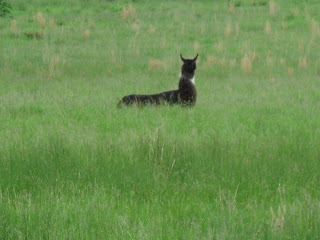We were able to spread the fleeces over an outside table in the back yard - not quite the ideal sorting table, but it served the purpose - a lamb sized fleece fits well - a ewe's fleece is way too large, but once trimmed is generally manageable.
We did three bags - about 10 fleeces all told - with the same sort of figures I had struck at home (with the total of 3 bags I sorted there) - a reduction by about a 1/3 to a 1/2 by weight. All this in 90+ degrees - I sweated buckets!!
We did find the 'best' fleece to date - relatively clean and nice and long staple, which makes a nice musical ping when tugged - it will clean up and spin really well. The goal will be to wash as much as I can in a couple of loads as often as possible and re-package into 'lots' of wool for spinning and dyeing to build up stocks in preparation for hiring a loom from the guild and turning it into cloth.
Some ways off...
 |
| sorting a lamb's fleece |
 |
| sorted wool in storage bags |
 |
| sorting a ewe's fleece |










